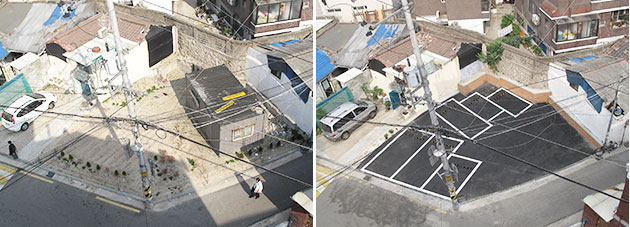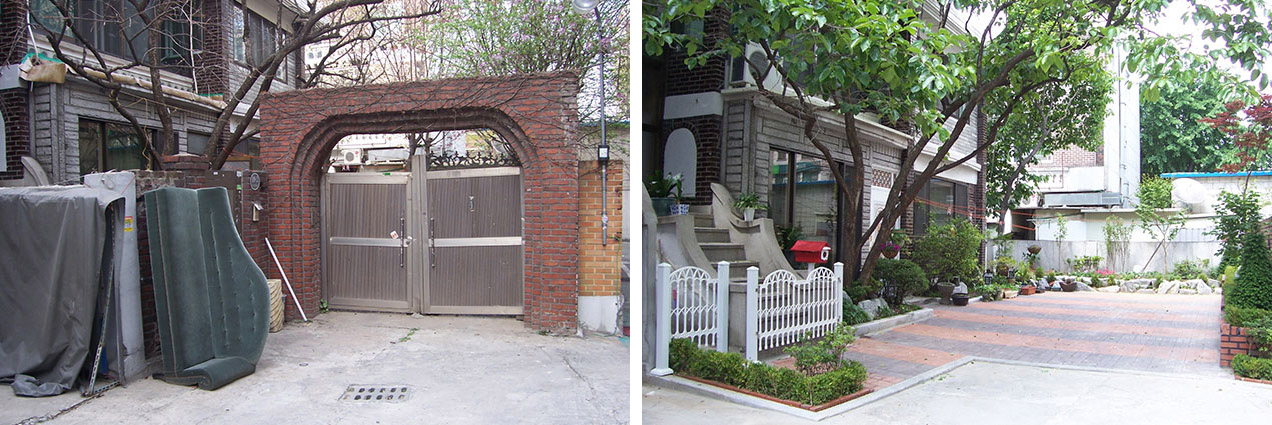A big issue in Korean cities is parking. Cars park everywhere. They block sidewalks, pedestrian crossings or a road lane. It is well documented in the Korean Parking Tumblr and it even led to a disruptive idea. Just recently I discovered a policy named “Green Parking” (그린파킹). As this article is going to show, the policy has a good intention but a bad impact on the city.
An article about the Green Parking policy has the following picture:

(Source: Seoul Media Hub)
Just by reading the keyword green parking I assumed that the picture above shows the transformation of a parking space to an urban farming space. Oh but wait… Isn’t normally the before-picture on the left and the after-picture on the right? Then I inspected the second before-after comparison:

(Source: Seoul Media Hub)
Hm, the parking lot looks really new. After reading the article, I realized that I was wrong: The Seoul Green Parking policy is about transforming space INTO parking lots. On both pictures the left side shows the situation before and the right side shows the situation after implementing the Green Parking policy.
Green Parking Policy
Seoul’s Green Parking policy provides financial incentives to house or land owners who transform their property or parts of the property to parking. The policy was introduced in 2004 and until 2014 a total of 48,867 parking places were made. 24,727 properties took opportunity of the policy. Seoul provides under this policy 8.5 million KRW for a single parking spot, 9.5 million KRW for two parking spots and a maximum of 27.5 million KRW for several parking spots. Here is another example of how the initiative can be used for residential buildings:

(Source: Seoul Media Hub)
It can be described as successful in creating off-street parking and removing cars from the road. Seoul saves a lot of money through this initiative. The construction of a public off-street parking space costs the city around 50 million KRW per lot but the Green Parking policy costs Seoul only 8.5 million KRW per lot. Advantage for house owners is that they create their own private parking lot. They don’t have to look for a parking spot after a long day at work.
In my opinion, the policy shows the high costs of parking and owning a car. Not only the financial costs, it is also about the environmental and social costs. From the perspective of a transport planner, the land may be unused but it is a green space in some cases. Replacing a possibly green house yard with a parking lot is a decrease in quality of life.
Here are more examples of this measure:

(Source: Seoul Transport Department)
A basic element of modern transport planning is to eliminate on-street parking because cars that occupy road space cause congestion. It is also very inconvenient and dangerous to walk on such streets with little space left for people who walk. It would be just better to reduce the supply of parking while providing public transport because avoiding demand for private cars is the best solution.
So this policy is outdated and recent planning thinks different about parking, right?
Still No Parking? Let’s Create Some!
Now, as most of you are familiar with transportation in Seoul, you would say that there are many buildings without parking lots and whole neighborhoods without any supply of parking.
Such a neighborhood is Dasan-dong in Seoul’s Jung-gu. The neighborhood lies on the outside of the Seoul city wall. Small alleys lead through the neighborhood without any space to park a car and some alleys aren’t wide enough for cars. Officials from Jung-gu district office announced that they are going to build parking for residents but the people in the area argue that they don’t need parking. The real intention behind the parking space is to provide parking for tourists. The area was recently designated as a new hip place, an artist quarter that is going to be developed receive cultural facilities and other amenities. Therefore, the district wants to build a 4,275 square-meter large public parking lot. The plan would displace 52 households, in total around 200 people. The majority of them lived their whole life in that neighborhood. If Jung-gu really proceeds with the plan, then they have to move away in order to make space for a parking lot. It isn’t connected to the Green Parking policy but the example stresses again the high costs of parking and private motorization.
Is it a sustainable approach?
The Seoul Green Parking policy isn’t so green after all and current parking policy development follows the wrong direction. Seoul tries to create more parking and it will lead to more traffic. In a city with such a high population density there is little space for cars. Seoul is well-known for a strong transport demand management. Parking is very limited in the city. The infrastructure for private motorization is as well. But both is made on purpose with the goal to keep the level of cars relatively low. The development in Dasan-dong and the Green Parking policy do not contribute to the sustainability of Seoul’s transport system.
Resources and Information: Green Parking | Seoul Traffic | Hankyoreh
The post Green Parking Initiative in Seoul appeared first on Kojects.





















